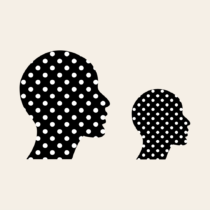A Pragmatic Approach Toward Brand Scenario Planning
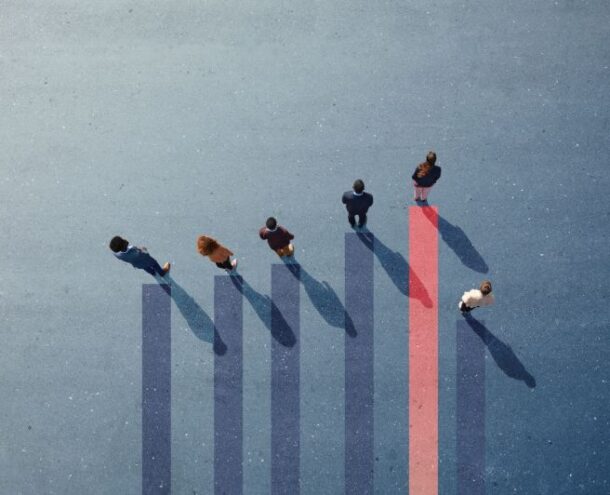
How to evaluate scenario planning for your brand as we emerge from this elongated crisis
In this two-part blog series, we will delve into the topic of brand scenario planning, in which you will see an in-depth perspective of how Monigle is thinking and pursuing this with our clients. Want to start a conversation about it? Reach out to us here
| Part 1: | Part 2 (read here): |
|---|---|
|
|
Synopsis
Because so much in our world is and will continue to change, brands need to re-think how they will show up and engage stakeholders in the future to stay relevant to a different set of needs, attitudes, and behaviors. While uncertainty will remain high for a while, there are things we can do to start planning and preparing for the future. One way to do this is to apply the concept of business scenario planning to brand strategy and laying out plausible future-states from which to conceive different directions to explore. This work will provide important mental models of the future which will help leadership to constructively conduct ongoing discussions without completely flying blind or being overly focused on getting through the current crisis. As many begin to consider what life will look like when we make it through this, it is time to begin developing hypotheses that shape an ongoing dialogue around how our brands might need to evolve.

Why brand scenario planning?
Such profound changes cause a re-orientation to life
In times of transformative change like those we are experiencing, we develop new views of the world and different relationships with organizations. As trust is shaken, we reevaluate what’s important to us and reorient our lives to re-gain our footing in what becomes our new normal.
Brands matter, more now than ever, but they risk losing their relevancy
When so much about our lives has been turned upside down, familiar faces, respected organizations, and even trusted brands act as psychological anchors that provide the comfort and confidence we need to settle ourselves and move forward. But, with a changed world, what provides this trust and re-grounding will also change. Brands will have to adapt with a newfound sensitivity to what we have gone through as a society, how our lives have changed (maybe forever), and what “really” is important.
Learn More: What Reassurance Means for Brands in the Age of COVID-19
We must re-orient our brands to a re-oriented world
Companies can’t wait for a completely clear picture of the future to emerge— they must begin to prepare for potential changes they will have to make. While business scenario planning helps to plan for financial management and operations, a company’s brand can be an effective rubric for thinking about how the company should relate differently to audiences in the future, how it internalizes its own sense of identity, and how it might solidify a perspective on the market to align leadership communications going forward.
But, re-orient brands to what?
When uncertainty is so extreme like in times like these, it is helpful to develop scenarios that bound possibilities and identify high potential drivers of tomorrow. While it is clear we are moving toward an even more digital way of life, there are many other things to consider when looking into the future. There are a mix of dimensions we might use to shape these scenarios and the implications to our brand. I describe some of them in this article based on my work with clients earlier this year, when outbreaks were at their worst.
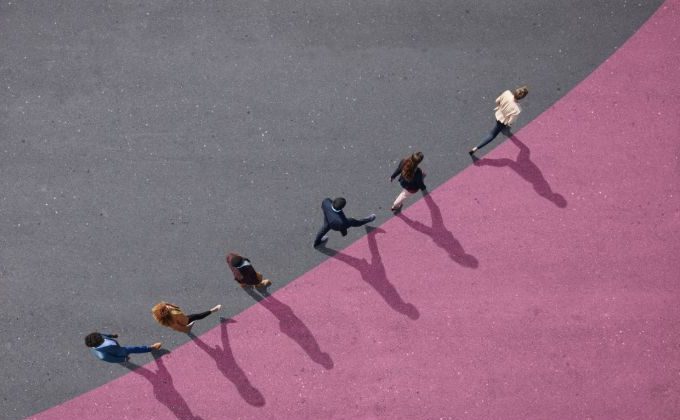
A proposed approach to Brand
At a high level, there are three, essential, steps in doing this work, which I will elaborate on in the coming pages:
1. What could happen in the future?
- Determine anchor scenarios to frame possible future-states
- Identify and prioritize macro trends potentially effecting our industry
2. How might we respond?
- Describe alternative positions we might take on the future
- Explore different brand scenarios based on those positions
3. What are the implications to the broader business?
- Identify major areas to imbed the brand and shape the customer experience
What could happen in the future?
To begin, it is important to develop some type of picture or framework of the future that provides context and a shared view among leadership. While there is a tendency to look at the future only through the lens of one’s industry, because so much might be changing, starting with a broader view is recommended. After a more holistic picture emerges, along with a perspective, position, or world view on the future, we can then identify which elements within that framework might be most impactful to our industry, business, and brand. Although there are many aspects that could shape how we think about the future, I have found two to provide valuable guideposts for this type of work: anchor scenarios and macro trends or what I call “uber themes”.
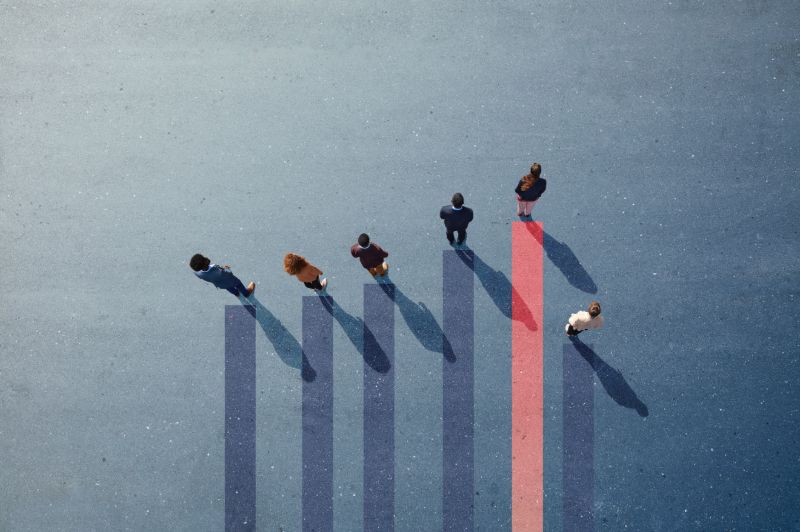
Anchor Scenarios
Anchor scenarios are a type of organizing principle that naturally emerge from the societal debate around what the future holds. As we have seen so much written about Covid-19 and how things might evolve, there is no shortage of “scenarios”. Because there are so many different versions and types, however, it is important that we are clear about which ones to ground brand visioning work. The type of scenarios that are the default way of conceiving of and debating the future is what I would call “recovery scenarios”, which are based on the speed, trajectory, and phases of a return to economic health. While many shapes of recovery scenarios exist, all follow three, basic phases, each dependent on containment of the virus itself:
- A period of “in the crises” or “contraction and reaction”, when shock and disruption occurs, companies exercise crisis management, attempts are made to contain the spread of the virus, and massive economic interventions take place. (clearly, we are still in this phase)
- A period of bouncing back or initial relief from the crises, when negative impact is mitigated, continued interventions occur (which move from relief to stimuli), and the beginning of return to some normalcy and hope.
- The long slog back, when long-term improvements are made to operations, new regulations take hold, and an economic re-balancing occurs.
Sources: BCG, Center for Strategic & International Studies
Learn More: A Cheat Sheet for Enabling Consistent Brand Experiences
These general phases are somewhat unanimously agreed upon by most economists, but there are several different variations based on the shape of the trajectory and speed with which the situation evolves, and therefore choices or bets to make about how we think recovery will materialize. Regardless, each trajectory is based on a combination of two factors: the spread of the virus and the public health response, and levels of effectiveness of a governmental response to the economy. The most prevalent shapes include the following:
V-shaped – Short time frame (rapid recovery)
- Rapid and effective control of the virus spread, vaccine takes a short period of time to develop and distribute
- Effective economic interventions
U-shaped – Moderate time frame (mixed case rollercoaster)
- Effective response, but virus recurs, vaccine takes a moderate period of time
- Partially effective economic interventions
L-shaped – Long time frame (decline & catastrophe)
- Broad failure of public health intervention, vaccine takes a long period of time
- Ineffective economic interventions
Sources: McKinsey & Company, Center for Strategic & International Studies
Another anchor scenario that might be important to guiding brand thinking would be the degrees of change, as there could be massive or moderate change associated with any of the recovery scenarios above. Specifically, degree of change can be defined by severity (how deep or drastic changes are to our constituencies) and scale (the proportion of entities and people in our world that are materially affected). We can envision four scenarios that depict different degrees of change:
- Most change: High severity / broad scale
- High severity / moderate scale
- Low severity / broad scale
- Least change: Low severity / moderate scale
And finally, there are looming geopolitical scenarios which could affect long-term recovery more than any other factor for certain industries. The two extreme versions of these include:
- Depression era nationalism, where de-globalization trends accelerate, yielding slow economic growth everywhere, as the potential for conflict between the US and a China increases
- New renaissance globalization, where a move back toward globalization helps to restore overall stability in the world while generating economic momentum
Source: Atlantic Council
While there are spectrums across each of these scenarios, the combination of bets or stakes-in-the-ground made within them will help establish a context for future discussions among leadership while aligning around a common vision. Determining which of these is most likely can require analysis and modeling of different factors, but can also be done with judgment-led facilitation to gain consensus around different future-states, providing there is strong rationale for making each bet.
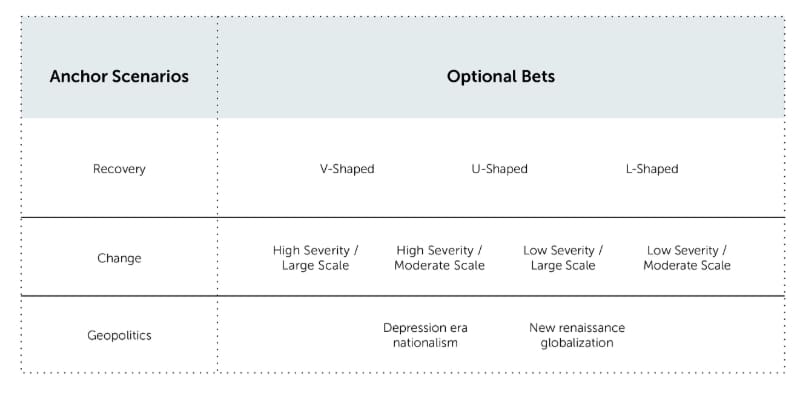
Learn More: Guiding Principles for Creating a Human Brand
Macro trend themes
The next aspect to get a handle on would be factors or trends that will shape the future, which can be independent of speed and trajectory. Like recovery type scenarios, there is no shortage of opinions of how tomorrow will unfold. The challenge here is two-fold: how to synthesize the multitude of predictions into something we can wrap our heads around, and how to encompass a broad enough view of these trends, as the most insightful ones tend to be narrow in their scope relative sectors or market segments.
We have taken a bottom-up / top-down approach here by first, looking at trends and predictions from highly credible sources within specific categories that in combination provide a broad-reaching view. The categories we have explored for clients include the following:
- Business and the economy
- Government and politics
- Work and workforce
- Science and technology
- Consumer dynamics
- Future of brand and marketing
- Client’s industry
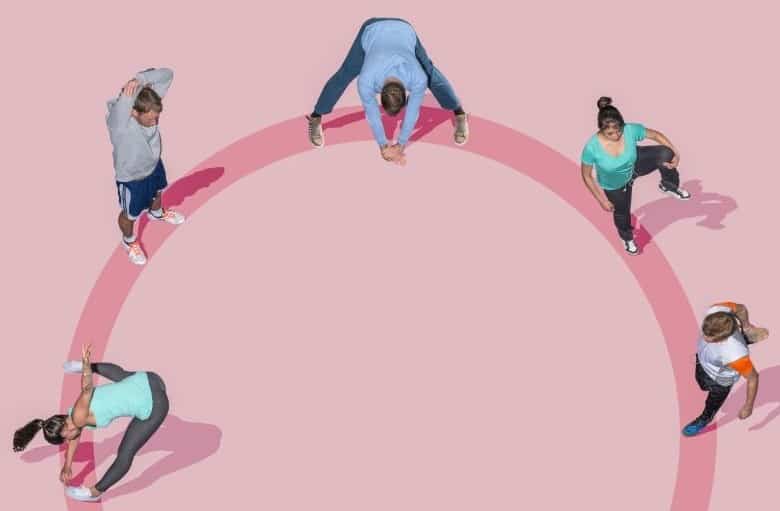
Within each of these, we have identified a MECE set of predictive trends by finding patterns in the best content from a host of thought-leaders and respected journalists (over 100 articles and white papers). Again, the intent of this work is to gain a broad contextual understanding of what could have the MOST far-reaching effect on the world in general, and later, by industry – in other words, we are trying to continually ladder up to the point of highest and broadest impact. Each of these trends has a story behind it which managers should understand to get a fuller context, but following are some bullet-pointed examples of the over 30 predictive trends identified.
- Business and the economy
- Economic stratification
- Inflation / stagflation
- Tempered capitalism
- Work and workforce
- Distributed, nimble teams, prevalence of WFH
- Increased role of home / decreased role of commercial real estate
- De-globalization / repatriating of supply chains
- Changing face of labor, need for re-training in digital work
- Consumer Dynamics
- Enduring societal trauma
- Desire for connection and community
- Returns to seriousness and faith in experts
- The enlightened consumer
While helpful in understanding high-potential factors that could shape specific categories, there is still a lot to digest, so we further aggregated these macro trends into broad themes that cut across categories, but begin to give shape of a potential future. The uber themes of tomorrow are meant to be the highest stakes in the ground of what might shape the future, and can be applied to different industries. As we did this work, it became clear that many of the things that are occurring because of the crises were already in play and will only accelerate our move toward them.
Examples of the ten identified include:
- A new or intensified world order (political landscape)
- Nationalistic tendencies play out, likelihood of cold war with China
- Necessity of government to step in with an elevated role, higher degree of oversight, new regulations
- Expansive safety net public programs – potential for some degree of universal income, health coverage, etc.
- Dislocation and imbalances (economic realities)
- Multi-dimensional inequality / severe hardship for many
- Major swings in supply and demand of talent
- Capacity imbalances
- Extreme disparity between winners and losers
- Contact-less services and experiences (how things will get done)
- Everything digital – intensifying social media / digitization of the value chain
- Prevalence of distributed WFH workforce
- Extended reality advances, TeleX
- Acceleration of IoT, AI, machine learning, blockchain, cloud, automation
In doing this type of work for clients, these broad themes proved to be very valuable, as they identified broad areas most agree will drive important and sweeping shifts in our future lives and markets, and thus provide a good starting point for discussions. As mentioned, while these themes are all applicable, different ones will have varying degrees of relevancy to different industries. Furthermore, the position a company takes on the future will have effect on which of these to focus on, as we will see.
Part II of Brand Scenario Planning
Check out Part II of this article – posting next week! In Part II, we will focus on:
- Positioning for the future
- Brand Scenarios based on posture positions we might take
- Role and strategy of our brand in the future
- Implications to the broader business
Ready to start a Conversation? Reach out to us here.

